November 9, 2018
Air Date: November 9, 2018
FULL SHOW
SEGMENTS
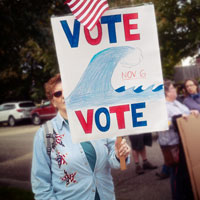
Democratic Wins And The Environment
/ Peter DykstraView the page for this story
The blue wave 2018 US midterm elections ushered in a Democratic majority in the House of Representatives, as well as several Dem majority state legislatures and governors who pledge to act on climate. It also ushered out some climate-denying Republicans. Host Steve Curwood and Peter Dykstra discuss the winners and losers, and how the environment fared in key ballot initiatives and gubernatorial and state legislature races. (09:56)
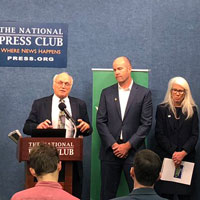
A Blue-Green Wave
View the page for this story
The day after the 2018 elections, some of America’s biggest environmental organizations gathered in Washington D.C. to lay out their priorities for the new Democratic majority in the House of Representatives. First and foremost is oversight of the Trump Administration’s environmental rollbacks and alleged corruption. The big green NGOs are angling for bipartisan, environmentally-minded legislation as well. They’re also celebrating Democratic wins in gubernatorial races and in several state legislatures, and warn the need to act on climate change is more urgent than ever. (04:04)
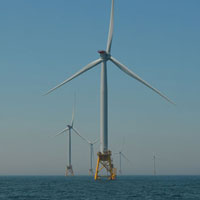
Trump Boosts Offshore Wind Power
View the page for this story
On October 18th, Secretary of the Interior Ryan Zinke, who has been embroiled in ethics allegations, announced leasing auctions beginning December 13th for offshore wind power in Massachusetts, with offshore locations in California and Rhode Island to follow in the near future. Joe Romm, a former Deputy Assistant Energy Secretary in the Clinton Administration, tells Host Steve Curwood about the opportunities and challenges for wind power on the continental shelf. (10:01)
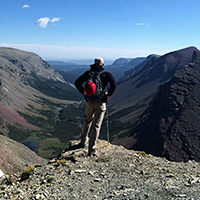
The Place Where You Live: Glacier National Park
/ Björn BeerView the page for this story
Software executive and writer Björn Beer describes the breathtaking beauty of Montana’s Glacier National Park and mourns the impending loss of the park's namesakes. It's the latest installment in Living on Earth's collaboration with Orion magazine that gives a voice to Orion's longtime feature in which readers write about the places they call home. (06:05)
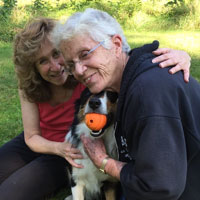
How To Be A Good Creature
View the page for this story
From tarantulas in French guinea to reclusive, aquarium-dwelling octopuses to the dogs and chickens in her own backyard, Sy Montgomery has connected with creatures all over the globe. They are her friends, her family, and especially her teachers. In her latest book, How To Be A Good Creature, she looks back on the valuable life lessons she’s learned from her friendships with feathered, furred and tentacled animals. Sy Montgomery joins Host Steve Curwood to discuss her treasured memories of these creatures. (14:30)
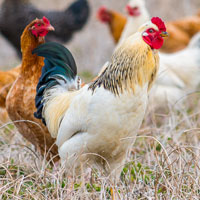
BirdNote®: How Free Is A Free-Range Chicken?
/ Mary McCannView the page for this story
When it comes to buying meat, certifications can be confusing. The term “free-range” chicken sounds good, but what exactly does it mean? If you’re looking for humanely raised poultry, there are a few labels to be aware of, BirdNote’s® Mary McCann tells us. (02:01)
Show Credits and Funders
Show Transcript
HOST: Steve Curwood
GUESTS: Sy Montgomery, Joe Romm
REPORTERS: Bjorn Beer, Peter Dykstra, Mary McCann
[THEME]
CURWOOD: From Public Radio International – this is Living On Earth.
[THEME]
CURWOOD: I'm Steve Curwood. The midterm US elections have many environmental advocates breathing a sigh of relief.
KARPINSKI: We stood here two years ago and there weren’t a lot of smiles. There are a lot more smiles on our faces today. I think as folks know, we’ve witnessed the last two years of the most anti-environmental president in history, and we’ve seen the most anti-environmental congress in history. And the good news is, yesterday the voters said, enough is enough, we need to go in a new direction.
CURWOOD: That will include oversight by House Democrats of the Trump Administration’s actions at EPA, Interior and beyond, as well as a push for progress.
BRUNE: We fully expect the House to enact a series of measures on climate change, on climate action, on clean energy, holding polluters accountable, and then put the pressure on the Senate to do the same thing.
CURWOOD: We’ll have those stories and more this week on Living on Earth – Stick Around!
[NEWSBREAK MUSIC: Boards Of Canada “Zoetrope” from “In A Beautiful Place Out In The Country” (Warp Records 2000)]
[THEME]
Democratic Wins And The Environment
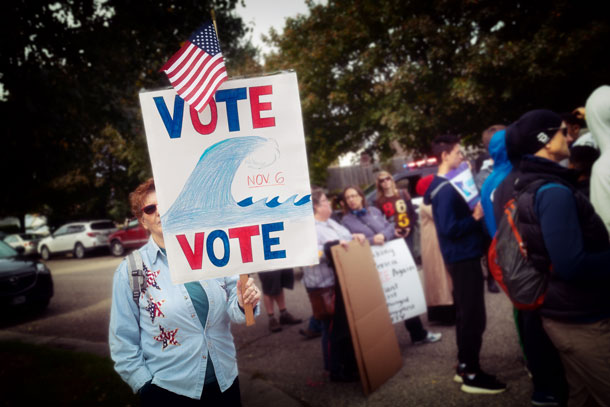
A Democratic Blue Wave campaigner at the Greater Than Fear Rally and March in Rochester, Minnesota. (Photo: Lorie Shaull, Flickr CC BY-SA 2.0)
CURWOOD: From PRI and the Jennifer and Ted Stanley Studios at the University of Massachusetts Boston, this is Living on Earth, I'm Steve Curwood.
The 2018 elections are mostly in the history books, and to sort out what happened and what might happen going forward, we're going to talk now to Peter Dykstra. Peter’s an editor with Environmental Health News, EHN.org, and DailyClimate.org. On the line from Atlanta, Georgia, hi there, Peter.
DYKSTRA: Hi, Steve.
CURWOOD: The Democrats now have one branch of the Congress. It's kind of like, before, President Trump was like a car with no brakes. Now at least there’s going to be some constraints on it.
DYKSTRA: Right, with the Supreme Court riding in the back seat. But with the House of Representatives back in Democratic control, there's going to be at least some moderation of what the Trump administration had in mind, for the environment. You know, one common thread in nearly all of the races and everything that we saw on Election Day is that environment and climate change were not considered to be important themes. But one exception is the American Petroleum Institute. They were all over the place with ads extolling the virtues of oil and gas, particularly one ad featuring the old Frank Sinatra song, “Come Fly With Me”, please don't make me sing it.
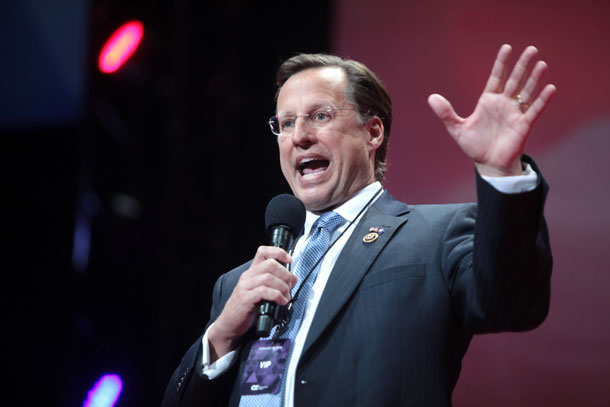
Dave Brat, an incumbent Republican Representative from Virginia with a zero rating in 2017 from the League of Conservation Voters, was defeated in the 2018 election by newcomer Democrat Abigail Spanberger. (Photo: Gage Skidmore, Conservative Review, Flickr, CC BY-SA 2.0)
CURWOOD: No, we won’t. Of course, where the environment was most clearly on the ballot was in the states. Let's talk about some of the initiatives that happened. Washington State, some folks there wanted a tax on carbon and it didn't go so well.
DYKSTRA: That's right. It was defeated by an absolute avalanche of fossil fuel industry money. There were a few others that had differing outcomes as well. Two identical initiatives, almost identical, in the states of Arizona and Nevada. And in Arizona, there was also an avalanche of money, but on both sides, mostly from Tom Steyer, the billionaire activist environmentalist, who was responsible for most of the $23 million spent on a state initiative in Arizona to pass a clean energy measure that would require the state utilities to be 50% clean energy by the year 2030. But with all that money it lost, and one of the reasons that it lost is that the utilities spent even more, about 30 million. However, in the state of Nevada, a very similar measure, 50% clean energy by 2030, passed and money was not quite so big a factor.
CURWOOD: And there were a couple of drilling measures, huh?
DYKSTRA: Right. Florida passed a measure that would ban offshore drilling in state waters. There was one that failed in the state of Colorado where voters there rejected measure that would have restricted oil and gas drilling on state-owned land.
CURWOOD: All right, now let's take a look at some of the people who are coming into Congress and some who are leaving - Marsha Blackburn.
DYKSTRA: Marsha is a Congresswoman from the state of Tennessee, a Tea Party darling. She won election as a US Senator replacing Bob Corker, a Republican who's retiring. She’s best known in environmental circles from back in 2012 when she led an effort against energy-efficient light bulbs on behalf of an incandescent light bulb manufacturer in her district. Her environmental performance as a member of the House of Representatives was pretty low. If she recycled a couple sheets of paper in her office in the senate, it would be an improvement.
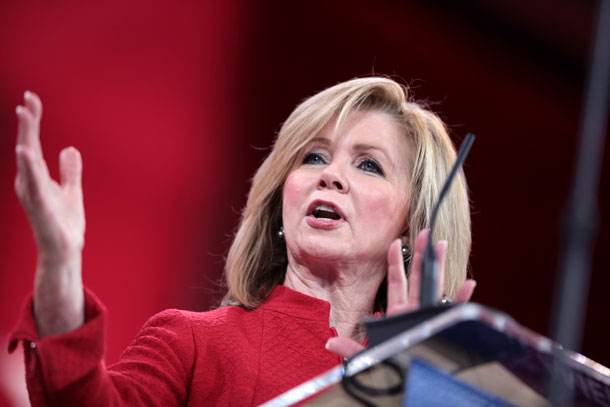
Marsha Blackburn, Tennessee Republican Senator-Elect, came under fire in 2012 for criticizing higher-efficiency standards for light bulbs, stating they would create a “de facto ban” on incandescent bulbs. (Photo: Gage Skidmore, Conservative Review, Flickr, CC BY-SA 2.0)
CURWOOD: Now, another Tea Party hero was Congressman Dave Brat. Tell me his story.
DYKSTRA: Well, Dave Brat became a phenomenon four years ago, he was a conservative college professor who challenged Eric Cantor in the primary for a congressional district in suburban Richmond, Virginia. Cantor was a rising star among Republicans, he was House Majority Leader, tabbed as a potential future Speaker of the House, and all of a sudden Dave Brat comes along out of nowhere, beats him in the primary, wins the general election, serves four years, compiled a lifetime League of Conservation Voters score of 1%. He was defeated this past week by a Democrat, also an unheard of in politics, named Abigail Spanberger.
CURWOOD: One of more than 100 women now who have entered the House thanks to the Democratic surge. Talk to me about some more of the Republicans that will be gone now. What about Dana Rohrabacher? He’s been in Congress for a long time.
DYKSTRA: He’s been there forever - 30 years in Congress representing Orange County. He’s, get this, an avid surfer, and an avid opponent of the Clean Water Act and other measures to protect the ocean. One would think a surfer would kinda like those things. He was also an avid opponent to climate science. He was second-in-command on the House Science Committee. He lost his race to a modern Democratic businessman named Harley Rouda.
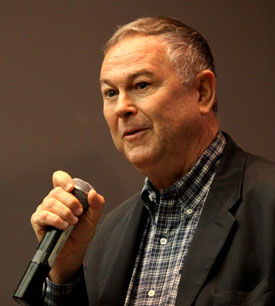
Dana Rohrabacher (R-CA), a climate change denier, lost his election in 2018 – ending his 30-year run in Congress. (Photo: Gage Skidmore, Conservative Review, Flickr, CC BY-SA 2.0)
CURWOOD: Now there was another Republican who lost, who many thought was pretty friendly to the environment. That's Carlos Curbelo, Republican from South Florida who started and co-chaired the Climate Solutions Caucus.
DYKSTRA: Yeah, friendly to the environment when compared to other Republicans in the growing void between Democrats and Republicans on environment. Curbelo represented the farthest-south district in the state of Florida, including the Florida Keys, a little bit of the Gulf Coast and the southern suburbs of Miami, meaning his entire district, according to sea level rise projections, is going to be underwater sometime in the next century. We talked a lot about redistricting and gerrymandering and moving districts around for political reason. They've got nothing on Mother Nature. Once Mother Nature gets set on redistricting South Florida, there may not be any South Florida anymore. Hence, Curbelo is a Republican talking about climate change. The Climate Solutions Caucus and Congress had a whole lot of skepticism from the environmental community that they were out to accomplish anything. Well, Curbelo lost his job on Tuesday to an up and coming Democrat named Debbie Mucarsel-Powell, and there'll be a new look in South Florida as a result.
CURWOOD: And of course, another woman in Congress. Now, in the past, the Republicans had a number of folks who really focused on science, I'm thinking of, he's gone, but I guess a Democrat, a scientist was elected that people are kind of bullish about who care about environmental change. His name is Sean Casten. Tell me about him.
DYKSTRA: Yeah, Sean Casten is somebody that not only has environmentalists excited, but scientists as well. There's been a push for the past year or so to get scientists more involved in politics, and to have some actually run for office. Sean Casten ran for congress and won. He has postgraduate degrees in molecular biology and in engineering. He's also a successful entrepreneur in clean energy. He took on a six-term congressman named Peter Roskam in the Chicago suburbs. Roskam had already been under environmental criticism for ignoring pollution from a local factory. Casten came in with a new voice in suburbs ready for a change, and expect him to be a big, loud, well-educated role model of a successful clean energy entrepreneur in the House of Representatives.
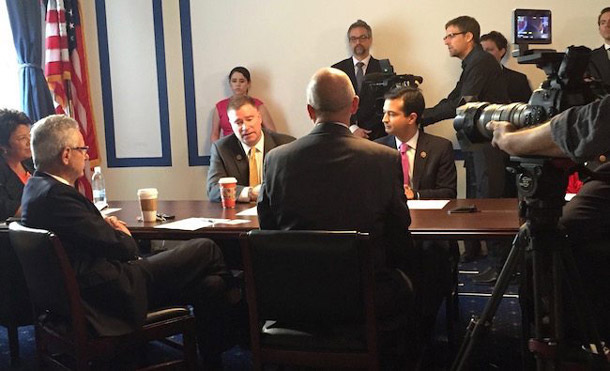
Florida Republican Representative Carlos Curbelo helped found the bipartisan Congressional Climate Solutions Caucus, but he was voted out of office in the 2018 election. (Photo: Climate Solutions Caucus)
CURWOOD: And you have a few more goodbyes for us, of folks we won't see as the new Congress moves forward.
DYKSTRA: Well, let's cue the “aloha” music for Lamar Smith, the veteran Texas Congressman, recently the chair of the House Science Committee, who used that committee, as sort of a chamber of inquisition for climate scientists. And his pal from Texas, “Smokey Joe” Barton, who got that nickname from environmentalists because he was close friend of all manner of polluter. His claim to fame back in 2010 was demanding that President Obama apologize to BP for being so mean to them over the Gulf Oil Spill.
CURWOOD: And who else do you have in mind?
DYKSTRA: We got a governor, Paul LePage in the state of Maine. His most famous moment was when he dismissed risks of BPA, the potential endocrine disruptor, by saying the worst case would be that some women would get little beards.
CURWOOD: And Governor page is being replaced by a woman - Janet Mills.
DYKSTRA: Right. And one more is Darrell Issa, the Southern California congressman who's retiring. He pushed to investigate climate scientists and on his retirement, he was replaced by another clean energy zealot on the Democratic side.
CURWOOD: So, there was a lot of negative advertising in this campaign, but not so many on the environment, huh?
DYKSTRA: Carlos Curbello’s the only one I know of who ran negative ads on the environment. The woman that beat him, Debbie Mucarsel-Powell was said to have taken coal money tied to Tom Steyer, believe it or not. Other than that, here in Georgia, for example, we were absolutely buried with attack ads about the governor's race. We’ll know that environmental issues have hit the political big time when politicians routinely use these ads to pollute the environmental discussion.
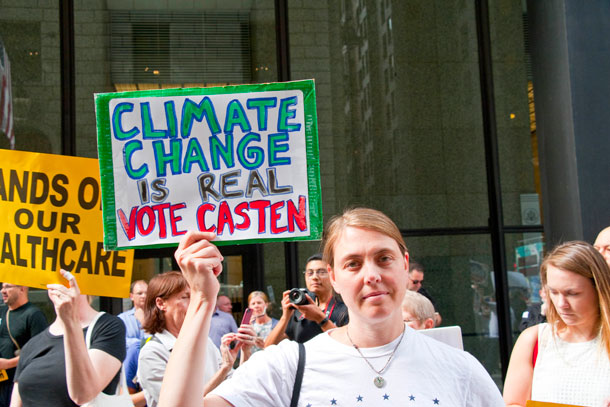
One of the reasons behind Congressman-elect Sean Casten’s (D-IL) robust support was his background as scientist and clean energy entrepreneur. (Photo: Charles Edward Miller, CC BY-SA 2.0)
CURWOOD: You know, Peter, once upon a time, the environment was a bipartisan issue. And Republicans did things like start the EPA. When do you think we'll get back to that?
DYKSTRA: You can go back further than that, to Teddy Roosevelt and all of his conservation values. It's hard to say when we'll get back to that, or if we'll get back to that. All we know is that we're not there now. And it's going to be a long road ahead. And if the two parties want to define themselves on differing environmental values, we’ll be headed in the wrong direction again,
CURWOOD: Indeed. Seems to me that it is just one planet, not a Democratic or Republican one. Peter Dykstra’s with Environmental Health News, that’s EHN.org, and DailyClimate.org. Thanks, Peter, we’ll talk you again real soon.
DYKSTRA: All right, Steve, thanks a lot. We'll talk to you soon.
CURWOOD: And there's more on the election at our website, LOE.org.
Related links:
- The Washington Post | “Voters Rejected Most Ballot Measures Aimed at Curbing Climate Change”
- League of Conservation Voters: Representative Dave Brat’s National Environmental Scorecard
- PolitiFact | “Marsha Blackburn Says She Is Battling for Freedom of Choice – for Energy-Inefficient Light Bulbs”
- Chicago Tribune | “Democrat Sean Casten Declares Victory Over US Rep. Peter Roskam in Pivotal 6th Congressional District”
[MUSIC: https://www.youtube.c om/watch?v=zZpB2CcuKq8
The Philadelphia Orchestra/Eugene Ormandy, “Fanfare For the Common Man” on Copland: Greatest Hits, by Aaron Copland, RCA Victor]
CURWOOD: Coming up, what the Democratic victories might mean for the environment, that’s just ahead here on Living on Earth.
ANNOUNCER: Support for Living on Earth comes from the Gordon and Betty Moore Foundation and from a friend of Sailors for the Sea, working with boaters to restore ocean health.
[CUTAWAY MUSIC: https://www.youtube.c om/watch?v=zZpB2CcuKq8
The Philadelphia Orchestra/Eugene Ormandy, “Fanfare For the Common Man” on Copland: Greatest Hits, by Aaron Copland, RCA Victor]
A Blue-Green Wave
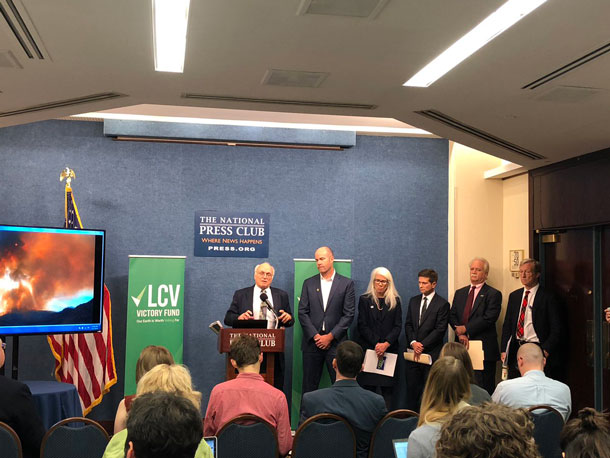
From Left: Gene Karpinski of the League of Conservation Voters, Michael Brune of the Sierra Club, Wendy Wandlandt of Environment America, Joe Bonfiglio, of EDF Action, Kevin Curtis of the NRDC Action Fund, Tom Steyer of NextGen America at the November 7th, 2018 environmental NGO press conference. (Photo: Tiernan Sittenfeld / LCV Twitter)
CURWOOD: It’s Living on Earth. I’m Steve Curwood.
The day after the recent elections, some leaders of national environmental organizations invited in the Washington press to hail the end of one-party rule in America, at least for the next two years or so. Big environmental NGOs spent record amounts on the 2018 midterms, with the League of Conservation Voters alone spending more than $80 million. LCV President Gene Karpinski.
KARPINSKI: We stood here 2 years ago and there weren’t a lot of smiles. There are a lot more smiles on our faces today. I think as folks know, we’ve witnessed the last 2 years of the most anti-environmental president in history, and we’ve seen the most anti-environmental congress in history. And the good news is, yesterday the voters said, enough is enough, we need to go in a new direction.
CURWOOD: And part of that new direction includes working with the new Democratic majority in the House to hold the Trump Administration accountable.
KARPINSKI: First of all we need intensive oversight. We've seen the Trump Administration try to repeal the Clean Power Plan, try to repeal the clean cars rules, corruption at Interior, corruption at EPA. So we need intense oversight of the executive actions at EPA and Interior and other places.
CURWOOD: Michael Brune, Executive Director of the Sierra Club took the microphone to push for progress, as well.
BRUNE: We fully expect the House to enact a series of measures on climate change, on climate action, on clean energy, holding polluters accountable, and then put the pressure on the Senate to do the same thing.
CURWOOD: Infrastructure could become a point of bipartisan cooperation. Again, the LCV’s Gene Karpinski.
KARPINSKI: We've heard a lot of conversation about an infrastructure bill. A smart infrastructure bill actually creates new jobs, new clean energy jobs, that protect the planet and create a much more sustainable society.
CURWOOD: Environmental philanthropist Tom Steyer, of NextGen America, struck a cautionary note.
STEYER: We’re in a place at the federal level where we have an ability now to be represented in one of the branches of government, but have no ability to pass legislation.
CURWOOD: And he said the lack of progress could be deadly.
STEYER: The UN described not solving the climate problem by 2030 as causing unimaginable suffering. In terms of actually solving the problem – it’s not give it the good college try by 2030, it’s succeed by 2030. We’re very far from doing that and in fact it is unclear to me that we can summon that will without having substantial political victories across the board.
CURWOOD: Democrats not only won control of the Lower House of Congress, but as Gene Karpinski noted, they also gained majorities in several state houses and won more governorships, boosting the movement to cleaner energy to fight climate disruption.
KARPINSKI: 8 Governors, new governors, signed a 100% clean energy pledge. So a lot of progress will continue to happen in the states.
CURWOOD: Again, Michael Brune.
BRUNE: We know that Governors are the ones who make decisions on how Clean Air Act and Clean Water Act and other environmental safeguards that are promulgated by EPA, governors make decisions on how those regulations are enforced. Does a coal plant stay online, or does it move to - is it replaced with clean energy. Governors have a tremendous voice in that question. Do we invest in new fossil fuel infrastructure or do we transition to clean energy? Governors have a big voice in that. Are we regulating the oil and gas and coal industries? Governors play a big role in that as well.
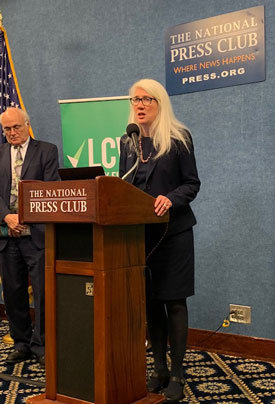
Environment America’s Wendy Wendlandt spoke about the continuing need to connect environmental voters with the ballot box. (Photo: Courtesy of Katie Murtha)
CURWOOD: The Environmental Voter Project has studies that show of 20 million or so registered voters in the US that have the environment in their top two criteria for voting, only about 20 percent, known as “super environmentalists,” actually voted in the 2014 midterm elections. In contrast 35 percent of the general electorate turned out.
The 2018 data is not yet available, but as Wendy Wendlandt of Environment America noted, without more turnout, politicians can continue to discount the environmental movement.
WENDLANDT: We didn't win everywhere. And we know that. And I think that's on us as the environmental community to figure out how to connect the concern we know exists among environmental voters with the ballot box. There was some progress made on that in this election cycle but we need to do more, and we're ready for that challenge as we go into 2020.
Related links:
- Inside Climate News | “Clean Energy Is a Winner in Several States as More Governors, Legislatures Go Blue”
- Motherboard | “For the First Time Since 2010, People Who Accept Climate Change Control the House Science Committee”
[MUSIC: Cliff Eberhardt, “500 Miles” on 500 Miles: The Blue Rock Sessions, by Hedy West, Red House Records]
Trump Boosts Offshore Wind Power
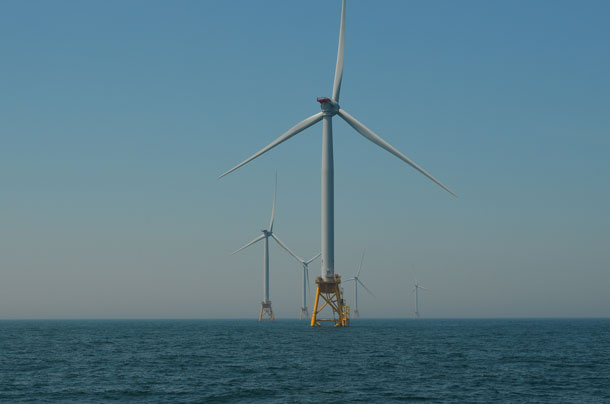
Block Island Wind Farm in Rhode Island is the first offshore commercial wind farm in the United States. (Photo: USW District 4, Flickr CC)
CURWOOD: One of the many things environmental groups are hoping for with a Democratic House is more oversight of alleged corruption in the Trump Administration.
And on that list is the Interior Department Secretary Ryan Zinke. Mr. Zinke is now subject to more than a dozen different investigations concerning his actions as head of Interior. Bobby McEnaney, of the Natural Resources Defense Council, says the allegations run from relatively minor to deeply troubling.
McENANEY: There have been issues of him forcing employees to walk his dog. He took a personal trip to Greece and Turkey with his wife and there was a security detail that was afforded to him, which tax payers end up paying for. There was a boat trip to the Channel Islands where he took political donors along with him and didn’t inform the Department of Interior that there were associations with his political backers.
CURWOOD: The NRDC’s McEnaney worries that Secretary Zinke is serving at the behest of industry groups he’s supposed to regulate, and not the American people.
McENANEY: What we see with Ryan Zinke and this administration is an effort to suit the oil and gas and other industry developers. He has said directly to oil and gas developers at conferences, “I serve you. I am here for you.”
CURWOOD: The Trump administration recently reduced two national monuments in Utah. Secretary Zinke is being investigated for his role in that decision which also happens to be a boon for one of his political allies, a uranium mining company. And then there’s the Arctic…
McENANEY: We’ve seen a rush to open up oil and gas resources in Alaska and there are a number of oil and gas lobbyists who used to work on that issue who now basically make the decision at the Department of Interior on whether or not oil and gas is developed in Alaska or in other parts.
CURWOOD: While Secretary Zinke has his ethical troubles there have been positive reactions to his announcement in October of offshore wind initiatives. He laid out the next steps in auctioning offshore wind leases in Massachusetts and California, as well as a review of the proposed offshore wind project off the coast of Rhode Island.
Secretary Zinke declared that “harnessing this renewable resource is a big part of the Trump Administration's Made in America energy strategy.” Here to talk more about the announcement is Joseph Romm, a former deputy assistant energy secretary in the Clinton Administration and founder of ClimateProgress.org. Joe, thanks for being here today!
ROMM: Thanks for having me on.
CURWOOD: Folks were a little surprised to see that Interior Secretary Ryan Zinke wants to start leasing space for offshore wind. In fact, has set a date, December 13, for off of Massachusetts. What's going on with the Department of Interior and its offshore wind projects?
ROMM: Well, certainly it's a surprise in the sense that the Trump administration has been pretty anti-renewable energy and pro-coal and dirty energy, but Zinke is from Montana and they have a lot of wind power up there, and he seems to understand that wind power is the fastest growing form of clean energy in this country and around the world. So, he is supporting offshore wind, giving out leases off of Massachusetts and off of the state of California.
CURWOOD: Now, Secretary Zinke announced actual leasing dates off of Massachusetts. There have been big fights in Massachusetts about offshore wind power. Why does the Secretary of Interior think that there won't be push back from the public about these?
ROMM: In the case of Massachusetts, I think these leases are in a different area than the Cape Wind project, and I think the technology has improved greatly so that many of the concerns about offshore wind are decreasing. And at the same time, the economic benefit of it has been increasing because the costs have just been dropping.
CURWOOD: Now, I understand that California is in the process of working with the Department of Interior to develop a leasing plan offshore in California, but that requires changes in technologies, if I understand it. Talk to me about what California might be able to do.
ROMM: Sure. Well, you know, the difference is between the east coast United States where the continental shelf slopes gradually and California where the continental shelf drops off very sharply, so that if you want to place wind off the shore of California, it's going to be deep water, which means it won't be connected to the bottom. So, this has got to be a floating turbine, and floating turbines have been more challenging. But in the last couple of years, you know, we have seen just tremendous advances in offshore wind, and the beauty of offshore wind is that if you've lived near the coast, you know the breeze is a lot steadier and the turbines are bigger and higher up in the air than they used to be, so we're also getting steadier wind here. And so literally, the wind is available as much as you get from a typical natural gas power plant. So, the technology has gotten better and the ability to operate in deep water is really opening up the possibilities of offshore wind off not just the coast of the United States, but around the world.
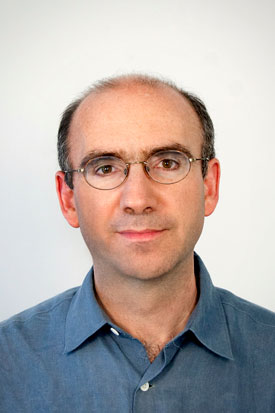
Joe Romm served as Acting Assistant Secretary at the US Department of Energy’s Office of Energy Efficiency and Renewable Energy in 1997. (Photo: Center for American Progress)
CURWOOD: So, seeing the Trump administration move to leasing offshore wind energy, renewable energy, to what extent do you see this as significant progress, or would some see this as a token nod from Secretary Zinke?
ROMM: It's clearly just a drop in the ocean, as it were, compared to the much larger attack on clean energy and clean power that the administration has launched. Clearly, the administration has said it's going to withdraw from the Paris Climate Agreement. So, that global effort to reduce carbon pollution and move off of fossil fuels, that’s a setback. At the same time, the Trump administration is working to roll back Barack Obama's Clean Power Plan, which would help, again, reduce carbon pollution, reduce the use of dirty fossil fuels. So, whether you look at the Department of Energy, or the EPA, or what President Trump is doing, by and large it is a very disaster for those who want clean air and clean water for their children and a livable climate.
CURWOOD: Talk to me about what these proposed projects would do. The Massachusetts bidding, how big is it? How many homes might it power? What California is looking at for offshore wind in this Trump administration plan? How much power would we get from that?
ROMM: I don't want to make it look like the process is far along. We're now at the stage where people are putting out leases to bid, and how many people are going to bid and how the projects go along. Ultimately, yes, we're talking about projects that could power hundreds of thousands, if not millions of homes. There's no question about it, that the opportunity is large. But it's worth noting, as you said, the one wind project off of Massachusetts has, you know, taken many years to get through all of the requirements. We only have, I think, one offshore wind project now that's going forward. So, you know, I think there's every reason to be very positive about the direction here, but the fact is, the United States has been very slow.
CURWOOD: By the way, to what extent would offshore wind be an employment program for American companies and workers?
ROMM: Well, there's no question that, this is a big job creator. When you look at traditional power plants, most of the jobs are in the building of the power plant. Whereas in the case of wind, you're actually, rather than building a power plant, and just sticking fuel in it, you're actually manufacturing these wind turbines. So, you generate really high paying jobs, and then you need the maintenance jobs. And so, one of the very fastest growing jobs in the entire United States is wind power technicians.
CURWOOD: So, let’s change subjects for just a moment here. We read in the Washington Post recently that there's been a 14-year long oil seep in the Gulf of Mexico. What can you tell us about that?
ROMM: Well, you know, I think people often when they think of oil spills, they think of these massive, very visible things, the Exxon Valdez, a big oil tanker running aground, or what happened with the BP oil spill, you know, a big explosion at an offshore platform. But there are places that have been just slowly leaking for a long time, and in this particular case, it's kind of been kept quiet. And people didn't realize that the individual daily rate of this leak is nothing compared to the daily rate of, you know, like the BP oil spill, but you know, it's been going on for over a decade. And it really underscores the need for oversight and investigation, which we haven’t been getting. I mean, and to be honest, the Department of Interior has actually under Zinke has been rolling back safety regulations that were put in place after the BP oil spill. The EPA has been gutting its Enforcement Division and letting people go and refusing to fill spots. So, you know, we're in a situation where there is very little oversight and people can be fairly brazen about it.
CURWOOD: There's a lot of skepticism about the Trump administration and concern that this move into wind power, there must be some catch. What do you respond to the skeptics?
ROMM: Well, I think people should clearly be skeptical of the Trump administration in general. If we had an administration that really cared about human health and welfare, then the focus would be on clean energy. And in this administration, it's just completely an afterthought. So I certainly want to praise Zinke, for you know, the positive effort towards offshore wind, but like I said, it's really a drop in the ocean compared to the disastrous policies across the board in the Trump administration.
CURWOOD: Joe Romm is founder and editor of ClimateProgress.org. His new book is called “Climate Change: What Everyone Needs to Know”. Joe, thanks so much for taking the time with us today.
ROMM: Thanks for having me.
Related links:
- Department of the Interior Offshore Wind Announcement
- ClimateProgress.org
- Joe Romm’s Bio on the Center for American Progress Website
[MUSIC: Curtis Mayfield, “Think” on Super Fly sound track, Rhino Records]
The Place Where You Live: Glacier National Park

From his perch at Siyeh Pass, Bjorn can see the Great Plains begin at the edge of Glacier National Park. (Photo: courtesy of Bjorn Beer)
CURWOOD: We head to Montana, Ryan Zinke’s home state, for a look at some of the effects of climate change expected by 2030, for another installment in the occasional Living on Earth/Orion Magazine series, “The Place Where You Live.” Orion invites readers to submit essays to the magazine’s website and put their homes on the map, and we give them a voice.
[MUSIC: Edward Sharpe and The Magnetic Zeroes “Home” from Edward Sharpe and The Magnetic Zeroes (Rough Trade Records 2009)]
BEER: My name is Bjorn Beer, and this is my essay on Glacier National Park.
Last summer I stood with my wife on the edge of a sheer cliff in Glacier National Park. We stared down towards the massive Grinnell Glacier. In that moment we decided to move to Montana. I can work anywhere with internet, and my wife had multiple job offers at hospitals across the country. We could have picked anywhere, but we decided to make this remote region our home, the center of our universe.
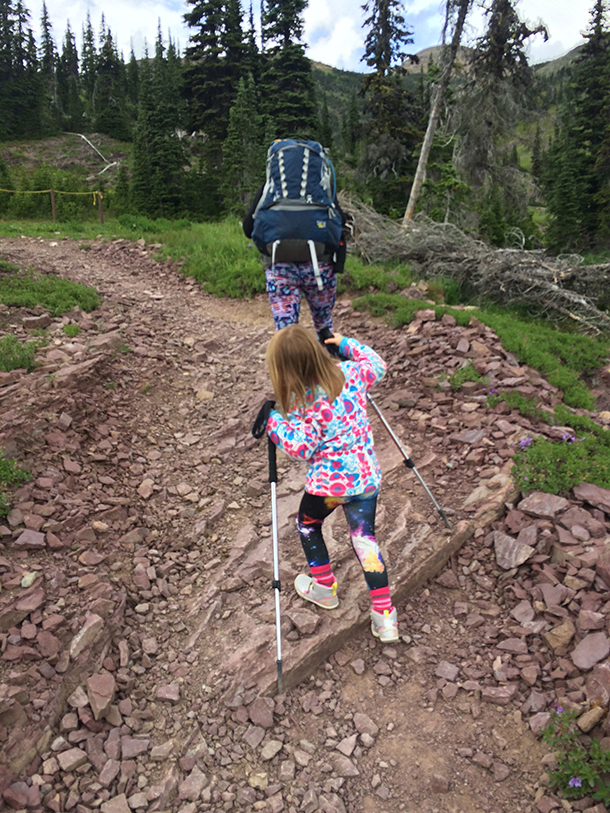
Freya and Mom taking the first steps on a steep side trip up to Swiftcurrent Pass. (Photo: Bjorn Beer)
[MUSIC: UNDER BEER’S NARRATION: BRIAN ENO, “ARAGON,” MUSIC FOR FILMS, https://www.youtube.com/watch?v=q5VIJor61uM]
As a writer, I’m surprised that I can’t find the exact words to explain why we chose to live in the Flathead Valley. Perhaps it’s the fact we’ll be on the largest freshwater lake west of the Mississippi, a definite advantage as the West becomes hotter and drier. Or maybe the proximity to the raw, jagged beauty of Glacier Park lifts my soul. Perhaps we were just drawn to the great skiing, hoping our daughter can experience this privileged pastime, as the autumn lingers longer, and spring accelerates bit by bit, year by year. I can’t tell you one rational reason why we chose Montana, so perhaps the rationale lies deeper, in emotion, in loss.
By the year 2030, all of these glaciers will be gone.
[SOUNDS OF TRICKLING WATER MIX WITH MUSIC UNDER BEER’S NARRATION: BRIAN ENO, “ARAGON,” MUSIC FOR FILMS, https://www.youtube.com/watch?v=q5VIJor61uM]
Blackfoot, Jackson, Sperry, Swiftcurrent, Grinnell, and dozens more. Their stately names will disappear as they melt and flow into the sea. Perhaps there is some guilt here, like the way we might not see a relative for years, but once she is on her deathbed, we feel compelled to visit, to commune, to see her before she loses her earthly form.
I want to be there as they melt. I want to hike back to Grinnell Glacier with my then teenage daughter in the year 2030 as the last sliver of ice sublimates into human memory. I will want to say, “I’m sorry.” I will want to say, “We tried.”
We were here last summer on an interview that my wife had here at the hospital. She was looking for jobs around the country, and we went up into the park on a very epic hike called the Highline trail. It starts off at a high pass.
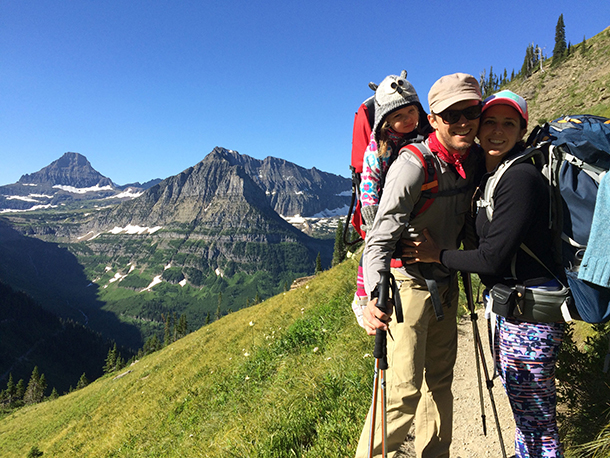
Bjorn, Amanda, and Freya Beer headed along the scenic Highline Trail en route to a night in the backcountry. (Photo: courtesy of Bjorn Beer)
[SOUND OF FOOTSTEPS]
And we ended hiking up to this ridge that overlooked this glacier, and it was just a tremendous experience. Climbing up this scree field, just a bunch of small stones that are a little bit hard footing on, a steep, steep trail up, you climb and climb for about 45 minutes, and the view that surprises you on the other side, you’re not expecting it but you can see Grinnell glacier a couple thousand feet below you and it just takes your breath away. It's this glacier that is calving off into Grinnell Lake. The water is this very bright, bright blue. It's just this amazing turquoise that provides this very stark contrast against the white glacier on these very dark cliffs, blue sky that, of course, we're in big sky country so you can see pretty far.
[MUSIC UNDER NARRATION CONTINUES]
What I love about wilderness like this is it so humbling, and Glacier Park in particular is exceptionally humbling because you have these very large animals that can potentially eat you, and the weather is incredibly extreme here, so you have to be prepared for anything, even a day hike you have to be prepared. We tried to hike up to the same overlook a couple weeks ago with our daughter, she's three-and-a-half and she was riding on my back.
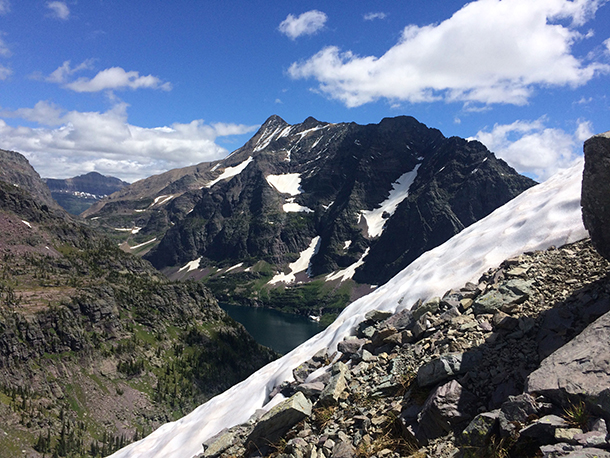
View from Lincoln Peak of glaciers on west side of Mount Jackson, which feed Lake Ellen Wilson. Permanent snowfield in foreground was used to test out Bjorn's new ice axe. (Photo: Bjorn Beer)
[SOUNDS OF THUNDER]
On the way to this hike, we couldn't actually summit because of a lightning storm, so we turned back around and stayed at a chalet that night and the next day we said, “Let's go up and show our daughter the Grinnell Glacier Overlook.” And there was a grizzly sow and its cub that were on the trail head up to this overlook so we ended up having to walk out with a ranger to avoid the grizzly.
[MUSIC CONTINUES UNDER NARRATION.]
It's hard to wrap your mind around when you're standing next to or above this glacier that in just a few decades it might be gone in the blink of an eye. Back in the 1800s, there were about 150 active glaciers. Today it's down to 25. Some people are saying that by the year 2030 all of these glaciers will be gone. At this northern latitude and with the glaciers, we're seeing the effects of climate change happen much faster in this part of the world. You do feel like you're almost a canary in a coal mine living here.
[TALKING TO HIS DAUGHTER] What we're going to do here, Freya, is we're going to record your beautiful song so that I can learn to sing.
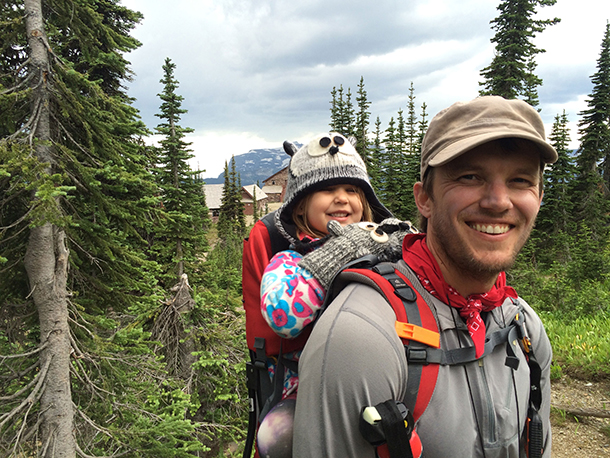
Bjorn and Freya Beer climbing up to Swiftcurrent Pass from the backcountry Granite Park Chalet in Glacier National Park. (Photo: courtesy of Bjorn Beer)
FREYA: OK. [SINGS] The Earth is good to me, and so I thank the Earth for giving me the things I need, the sun and the rain and the appleseeds. The Earth is good to me.
[MUSIC: "Johnny Appleseed," Instrumental piano recording arr. Bernie Cossentino for SongsForTeachers ]
CURWOOD: That’s Bjorn Beer’s three-year-old daughter, Freya, and his essay on Grinnell Glacier. There are pictures at our website, LOE.org, and there you’ll also find details about Orion Magazine and how to submit your essay, if you want to tell us about the place where you live.
Related links:
- Climate Change in Glacier National Park
- National Geographic Video: Photo Evidence: Glacier National Park is Melting Away
- Bjorn Beer’s writing for Earth Island Journal
[MUSIC: "Johnny Appleseed," Instrumental piano recording arr. Bernie Cossentino for SongsForTeachers]
CURWOOD: Coming up – learning how to be a good creature. Stay tuned to Living on Earth.
ANNOUNCER: Funding for Living on Earth comes from you, our listeners, and United Technologies, combining passion for science with engineering to create solutions designed for sustainability in aerospace, building industries, and food refrigeration. UTC companies such as Otis, Carrier, Pratt and Whitney, and UTC Aerospace systems are helping to move the world forward. You can learn more about United Technologies by tuning into the Race to Nine Billion podcast; listen at racetoninebillion.com. That’s racetoninebillion.com. This is PRI, Public Radio International.
[CUTAWAY MUSIC: Holly Near, “La Marusa” on Sing To Me the Dream (Un Canto Solidario), by Jorge Ball, Calico Tracks Music]
How To Be A Good Creature
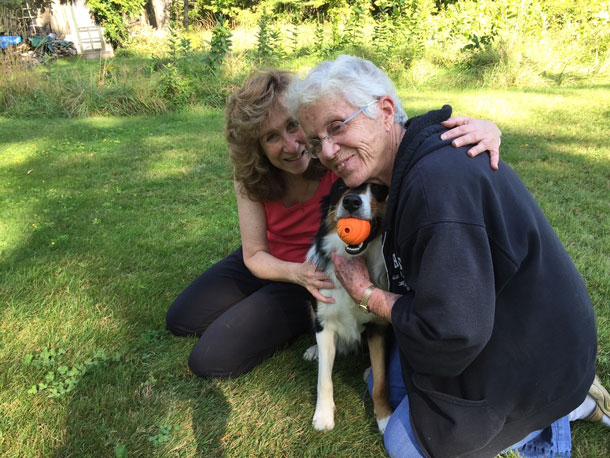
Sy Montgomery (left) poses here with her beloved Border Collie Thurber and friend Elizabeth Marshall Thomas at her New Hampshire farmhouse. (Photo: Steve Curwood)
CURWOOD: It’s Living on Earth. I’m Steve Curwood.
Author and long-time friend of Living on Earth Sy Montgomery has a new book, and it’s a New York Times Best Seller. In her memoir, How To Be A Good Creature, Sy tells us exactly that. And who knows better than Sy how animals can teach us how to be good inhabitants of the world? From tarantulas in French Guinea, to reclusive aquarium-dwelling octopuses, to the dogs and chickens in her own backyard, Sy has connected with creatures all over the globe. They are her friends, her family, and especially her teachers. Joining us now from her home in Hancock, New Hampshire, is author Sy Montgomery. Now, this book is a memoir that really talks about some 13 different creatures that have taught you how to be a good creature. And you start your stories with Molly, the dog.
MONTGOMERY: I'm looking at her picture right now on my desk. Yeah, Molly. Molly was essentially the older sister I never had. I mean, most little girls idolize their older sisters. I never had any siblings but I had something better. I had a Scottish terrier and even though she was chronologically younger than I was, I was very aware that dogs mature earlier than we do. They become adult in just a few years. We take, you know, 15, 18, 21 years to mature. But Molly was a fierce, strong, independent, wonderful, wise, adult individual. And I wanted to be just like her.
CURWOOD: Ah, your dog taught you to grow up to be a strong woman.
MONTGOMERY: Yes, she did. She totally did. And I used to dream of the day that I could run away with Molly, and live in a hollow tree or live in the woods somewhere, that with her, I'd be able to learn the secrets of the animals who lived in the wild. And that's what I went on to do.
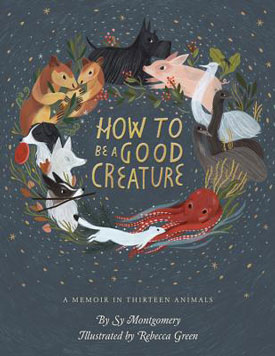
Sy Montgomery’s book, How To Be A Good Creature: A Memoir in Thirteen Animals, is a New York Times Best Seller. (Photo: The Toadstool Bookshop)
CURWOOD: Now, in your book, you recount your career, and it seems like you're well on your way to being the journalist, a little girl had a newspaper, and grown-up woman has job as a reporter, and you're all set to go, and then, well, something happens along the way.
MONTGOMERY: Well, my father, ever my champion, gave me the gift of a trip to Australia, and I didn't want to just go as a tourist. I wondered if there was some way that I could volunteer or do a study or, you know, help a scientist. And there was. There's an organization, as you know well, called EarthWatch. You can spend a couple of weeks helping a scientist almost anywhere in the world. So, I looked to see what they had in Australia. And what they had in Australia was a project called “drought refugia.” And this was a study with Dr. Pamela Parker of the Southern Hairy-Nosed Wombat. Now, who can resist that? Almost nothing was really known about them until Dr. Parker came along. So, for a couple of weeks we lived in tents in the Outback and by day we would try to find the wombats. And I was crazy about this. I had the best time and I worked really hard, and afterwards, Dr. Parker was impressed enough to say, Sy, I wish I could hire you to work for me. I wish I could buy you a ticket to come back and Australia, but I can't. But what I can do is, if you ever wanted to come back on your own, I'd let you stay at my camp and you could eat my food. So, I went back to my wonderful job. And I quit that job and moved to a tent in the Outback. And I studied emus.
CURWOOD: And, you write that the emus really taught you something important, what was that?
MONTGOMERY: They showed me a lot. I mean, I certainly learned a lot of field work knowledge from them, but the most important thing, Steve, it was that doing the science, doing the reading, all that intellectual stuff really matters. But, if you want to understand an animal, you also have to bring to that understanding your heart. I let them choose to be around me, and I wouldn't approach them so closely that they would feel frightened the minute that they seemed upset. I’d just back off and stay still. You know, at first I thought, I'm gathering important scientific data. This is really fun. And the data is important and taking notes is important. But the more I follow, the more I was with them. I found myself falling in love with them. And there were times that I realized that taking the notes wasn't the most important thing I was doing. Maybe the most important thing I was doing was falling in love.
CURWOOD: Indeed. Now, you're a writer, and so, there's always the editing process. Just how difficult was it for you to whittle your stories down to just 13 animals in 10 chapters?
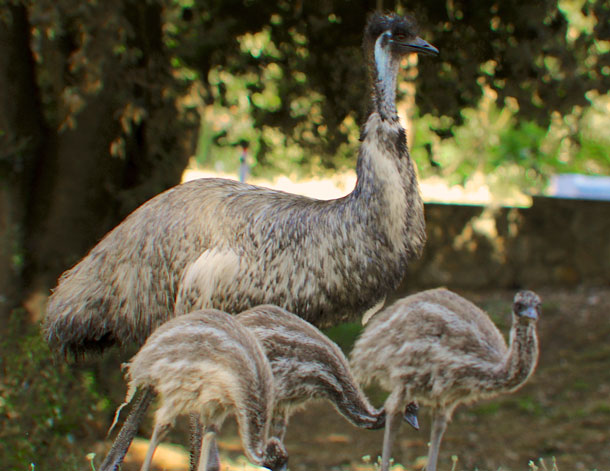
After her initial visit with the citizen science group EarthWatch, Sy Montgomery returned to the Australian Outback where she studied a trio of emus, like the above for an extended period. (Photo: Greg Scales, Flickr, CC BY 2.0)
MONTGOMERY: Well, I did leave out some important animals in my life, and they very much still animate my life. But the ones that I included in this memoir, it's a memoir in 13 animals, that’s the subtitle, are ones that taught me very specific lessons for my life about how I should perceive the world and how I should behave. And I chose those that best illustrated that. Some of the animals taught me how to cope with loss. Some animals taught me how to find your destiny. One animal showed me how to forgive, and Thurber showed me that there's always something wonderful lurking right around the corner that you can't possibly anticipate.
CURWOOD: Talk to me about how a creature taught you to forgive.
MONTGOMERY: Well, this was an ermine. They are the white-coated version of weasels, who live in the north. So, this weasel, ermine, who I meat, I met on Christmas morning. And every Christmas morning I always make my hens a big bowl of delicious hot popcorn. And I was carrying it down to give to the ladies. And one of my girls was lying dead on the floor of the coop. And someone had a hold of her head. And when I pulled her away, this white head popped out from the corner with coal black eyes. It was a tiny little critter. This animal probably weighed less than a handful of coins, but so fierce, and I could not be mad at that weasel. I mean, the animal had just killed someone who I loved and it was Christmas morning and you’d think that would make you really angry or that you might even hate someone who did that. But that wasn't what I experienced at all. What I experienced was the glory of this creature, the glory of its wildness, and its ferocity, and its determination, and its courage, its brightness. And I thought about my mother. And my mother had just died, oh gosh, that very year. But throughout my childhood and growing up and even as an adult, we'd had a number of disagreements and, at one point, my parents had disowned me for marrying the love of my life, Howard Mansfield. We had a lot of disagreements, but in the moment that I beheld that ermine, I just felt this wave of forgiveness sweep over me for my mother. And I realized that she was fierce like that weasel, she shared a lot of the characteristics of that ermine, and there was so much in her to admire, and I realized how much I loved her, and how much I missed her.
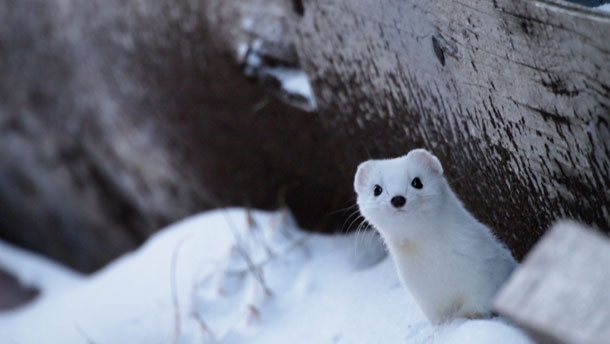
One of the lessons conveyed in Sy’s book was that of forgiveness, inspired by her forgiveness of an ermine that had killed one of the chickens she kept. (Photo: Fiona Paton, Flickr, CC BY-NC-ND 2.0)
CURWOOD: Now, you write about octopuses, in fact, a little shout out about us at the show when we went to meet one of your octopus friends at the New England Aquarium. How did you get into, well, talking and being with octopuses?
MONTGOMERY: The first octopus I met, I went in with an assignment for Orion Magazine on the intelligence of octopuses. And one of the keepers opened up the tank where Athena lived. And this huge animal, I mean, her arm span had to have been, oh, gosh, nine, ten, or more feet. She turned bright red with emotion. She slid from her lair, looking me straight in the eye with hers, and then out from the cold, 47 degree water come boiling up her arms, reaching for me with these questing suckers. So, naturally, I plunged my hands and arms right into the water to greet her. And the next thing I knew, I was patting her head. And she was just as curious about me as I was about her. And I came back several times to meet her. But the thing about octopuses is, they just don't live very long. And after only a few visits, I got the horrible news that she just died of old age. So, the next octopus who came, they invited me back to meet her, and that's the octopus, who you met, Steve, Octavia. And there's a chapter in this book about Octavia. And when I introduced you to Octavia, only once before had we had a close interaction. So, I really wasn't sure what she was going to do when she met you. But she was quite brilliant. She was interacting with you, and the producer, and the sound person. And while we were all petting, and feeding, and watching this octopus, just our senses being flooded with the sensation of touching this beautiful animal, feeling her suckers watching her change color right out from under our noses, she stole a bucket of fish, do you remember that?
CURWOOD: [LAUGHS] I do.
MONTGOMERY: [LAUGHS] She totally outwitted us.
CURWOOD: [LAUGHS] You know, I have to confess I was a bit fearful. I mean, I hadn't met an octopus before.
MONTGOMERY: Right. And they're depicted as monsters in all kinds of literature, and paintings, and etchings.
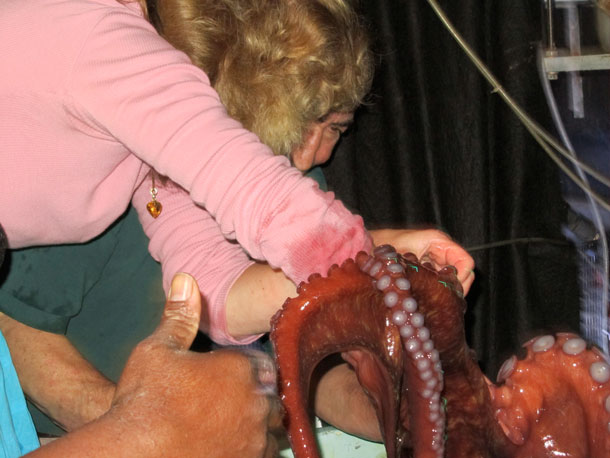
Octavia rises out of her tank to greet Sy. (Photo: Living On Earth)
CURWOOD: Yeah, when I reached in their first there was one sucker, and then there were several suckers, and everything attached. But thanks for you being there, I simply relaxed. But when I heard that she too died of old age and motherhood, I was sad.
MONTGOMERY: I know, I know, they just break your heart. But I knew her more intimately than any other octopus, because I knew her pretty much from when she first showed up at the aquarium until she died. And it was just so beautiful to be able to see the full arc of her life. And the last thing a mother octopus does is tend for their eggs. And even though her eggs were infertile, she tended them with all the tenderness and love that a mother octopus would feel for living eggs. And that was a real blessing to be able to see.
CURWOOD: Now you, I think you struggle at times with making sure to not anthropomorphize the animals in your stories. But you also make the point that, perhaps the worse mistake is to assume that animals are emotionless, that they don't have emotions.
MONTGOMERY: Exactly, exactly. What we don't want to do is project our feelings onto other animals, or other people. And so, and, we can't help it sometimes, you know, we can easily imagine that an animal wants to be petted, and when maybe it doesn't. That's a common mistake. But more dangerous, as you said, is to think that they don't have thoughts or feelings, thoughts and feelings are not human things alone. We're part of a huge family of living creatures, and consciousness does not belong to us alone. Emotion does not belong to us alone. These are things that are helpful to animals to let them live. So, we do ourselves and the creatures a terrible disservice to assume that they are thinking nothing, that they are feeling nothing, that they know nothing, that they do not make decisions. We will never understand the lives around us unless we realized that animals are thinking, feeling, knowing beings.
CURWOOD: So before you go, Sy, what do you hope to impart to animal loving listeners, or even those whose relationships with animals may be a little more tenuous or even skeptical?
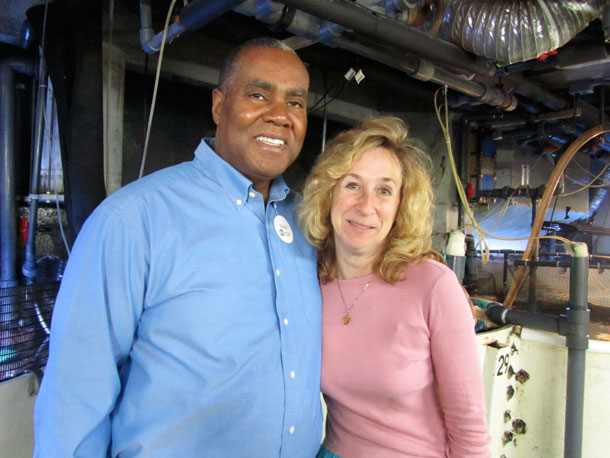
Host Steve Curwood and Sy in 2011, on a visit to Octavia the Octopus at the New England Aquarium. (Photo: Living On Earth)
MONTGOMERY: Well, I would want to say that we are embedded in this glorious world of other souls, other minds, and these others have so much to teach us. And being surrounded by teachers in a confusing and difficult world should make us feel far more at home here, and far more in love with our homes, and give us the courage to fight for this beautiful Earth that is so imperiled, and so alive.
CURWOOD: Sy Montgomery's book is called How to Be a Good Creature: A Memoir In 13 Animals. Sy, thanks so much for taking the time with us today.
MONTGOMERY: Oh, such a pleasure, Steve.
Related links:
- Sy Montgomery’s website
- How to Be a Good Creature: A Memoir in Thirteen Animals
- Our interview with Sy Montgomery and Elizabeth Marshall Thomas from 2017
- A previous LOE story where we met Octavia, the Giant Pacific Octopus
BirdNote®: How Free Is A Free-Range Chicken?
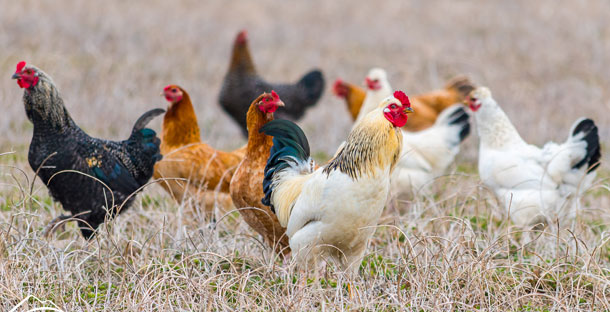
Free-range chickens do not always have full access to open pastures. Even outdoor time totalling a few minutes a day can earn chickens the free-range designation. (Photo: Washington State Department of Agriculture CC)
[BIRD NOTE THEME]
CURWOOD: One of the many creatures that Sy Montgomery has learned from are her backyard chickens, or the ladies, as she calls them. The humble chicken is also the subject of this week’s BirdNote from Mary McCann.
BirdNote®
How Free Is a Free-range Chicken?
Chickens are awake and ready to go well before dawn...
[Rooster crowing]
… and they start foraging at the first glimmer of morning light. They are laying eggs while you are still sipping your morning coffee.
[Chickens clucking]
But what exactly is a “free range” chicken? Next time you’re at the grocery store, take a look at the labels. According to the USDA, which regulates food labeling, “free range” or “free roaming” chickens need only be allowed some kind of access to the outside. That could mean all-day access to a lush pasture, or a tiny enclosure behind a door open for just a few minutes a day.
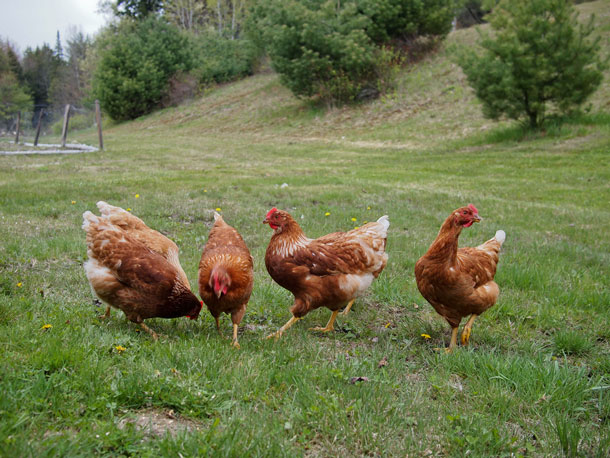
When chickens are raised “free-range,” their diet can be composed of different bugs and vegetation found in your own backyard. (Photo: Adam Chandler CC)
What if the label says “humanely raised”? It turns out, the standards behind that labeling can also vary quite a lot.
So if you wish to eat truly free-range chickens or eggs, how do you know what to look for?
Chickens raised for meat or eggs — that spend their days outside pecking for bugs, grubs, and fresh green vegetation — are best known as pastured poultry.
Look for labels that show the chicken was pasture raised or “Animal Welfare Approved.” If you can, buy from a local farmer. Or, if you have a big back yard, maybe even try raising your own chickens at home!
(Chickens clucking)
Your decisions at the grocery store can really make a difference – for local farmers and chickens alike.
I’m Mary McCann
###
Written by Bob Sundstrom
Chicken sounds recorded by C Peterson
BirdNote’s theme music was composed and played by Nancy Rumbel and John Kessler.
Producer: John Kessler
Managing Producer: Jason Saul
Associate Producer: Ellen Blackstone
© 2018 Tune In to Nature.org November 2018 Narrator: Mary McCann
References:
Pasture-raised labeling
http://homeguides.sfgate.com/benefits-freerange-chicken-79307.html
What is a “real” free-range chicken?
http://smithmeadows.com/farm/what-is-free-range-chicken/
https://www.birdnote.org/show/how-free-free-range-chicken
CURWOOD: For pictures, flock on over to our website, LOE.org
Related links:
- Learn more on the BirdNote website
- What that “Animal-Welfare Approved” certification really means
[MUSIC: Philip Boulding, “Ohana Kai” (Family of the Sea) on Musings, self-published]
CURWOOD: Living on Earth is produced by the World Media Foundation. Our crew includes Naomi Arenberg, Bobby Bascomb, Thurston Briscoe, Savannah Christiansen, Jenni Doering, Jaime Kaiser, Don Lyman, Lizz Malloy, Aynsley O’Neill, Jake Rego, Sarah Rappaport, Adelaide Chen, and Jolanda Omari. Tom Tiger engineered our show. Alison Lirish Dean composed our themes. You can hear us anytime at LOE.org, iTunes and Google Play - and like us, please, on our Facebook page - PRI’s Living on Earth. And we tweet from @livingonearth. Find us on Instagram, @livingonearthradio. I’m Steve Curwood Thanks for listening!
ANNOUNCER: Funding for Living on Earth comes from you, our listeners and from the University of Massachusetts, Boston in association with its School for the Environment, developing the next generation of environmental leaders. And from the Grantham Foundation for the Protection of the Environment, supporting strategic communications and collaboration in solving the world’s most pressing environmental problems. Support also comes from the Energy Foundation, serving the public interest by helping to build a strong clean energy economy.
ANNOUNCER 2: PRI, Public Radio International.
Living on Earth wants to hear from you!
Living on Earth
62 Calef Highway, Suite 212
Lee, NH 03861
Telephone: 617-287-4121
E-mail: comments@loe.org
Newsletter [Click here]
Donate to Living on Earth!
Living on Earth is an independent media program and relies entirely on contributions from listeners and institutions supporting public service. Please donate now to preserve an independent environmental voice.
NewsletterLiving on Earth offers a weekly delivery of the show's rundown to your mailbox. Sign up for our newsletter today!
 Sailors For The Sea: Be the change you want to sea.
Sailors For The Sea: Be the change you want to sea.
 The Grantham Foundation for the Protection of the Environment: Committed to protecting and improving the health of the global environment.
The Grantham Foundation for the Protection of the Environment: Committed to protecting and improving the health of the global environment.
 Contribute to Living on Earth and receive, as our gift to you, an archival print of one of Mark Seth Lender's extraordinary wildlife photographs. Follow the link to see Mark's current collection of photographs.
Contribute to Living on Earth and receive, as our gift to you, an archival print of one of Mark Seth Lender's extraordinary wildlife photographs. Follow the link to see Mark's current collection of photographs.
 Buy a signed copy of Mark Seth Lender's book Smeagull the Seagull & support Living on Earth
Buy a signed copy of Mark Seth Lender's book Smeagull the Seagull & support Living on Earth

